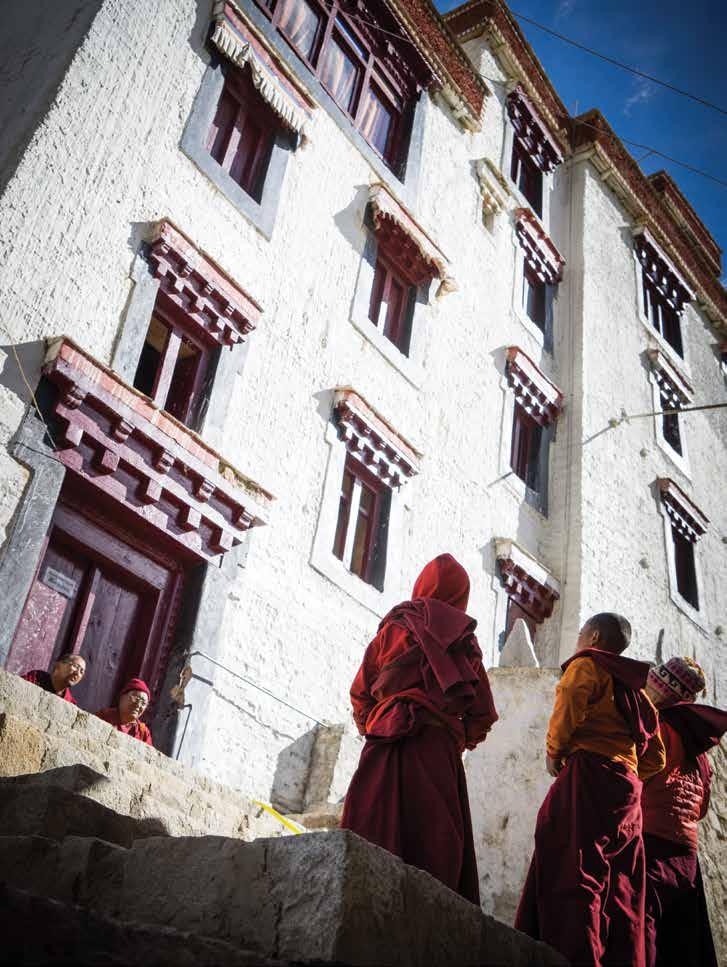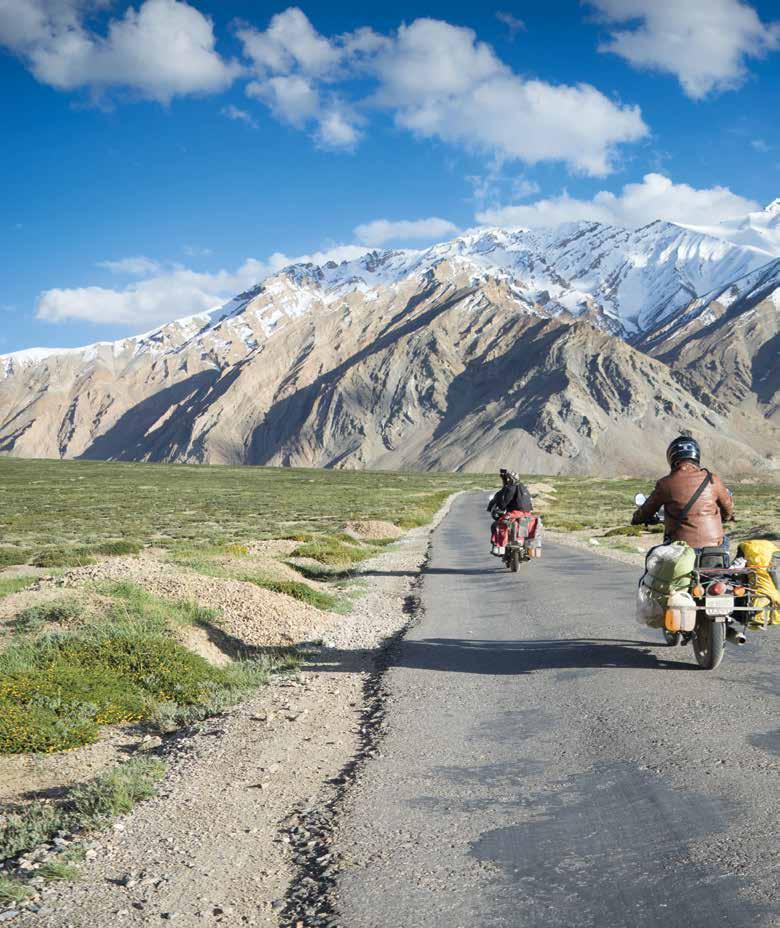
7 minute read
A Hope Spot
from Off Grid Adventures
Freediving in the Indian Ocean
Mozambique invites exploration at a slow pace. We’re headed to the coral island of Vamizi, set among the Quirimbas Archipelago. This eight-mile-long finger of island is one of the world’s most important biodiversity hotspots. A bastion of hope, it offers a deep dive in paradise. To get there, we admire Africa from above, flying low over the clearest blue water, with tiny remote islands all around us. Easing down, until our wheels touch the island airstrip and roll us to a gentle stop. Is it me, or does time seem to have slowed down already?
The island is blessed with a tropical climate and powder-soft sandy beaches that rival those of the Maldives. We stay in one of only six secluded villas on the island. Nestled in the shadow of mature casuarina trees, each has its own access to the beach. An easy encounter with the untamed, so far. I can’t wait to explore and jump into a kayak to get a first glimpse of the environment. As it’s still early morning, kingfishers and cicadas fill the air with their dawn songs. I glide almost effortlessly over the glass like water and drift past mangroves along the shoreline. With tropical temperatures of about 35 °C, I’m looking forward to spending time in the water and exploring the healthy coral reefs around.
Butterfly effect
All over the tropics, reefs are in terminal decline, prey to global warming, overfishing and pollution. In parts of the Indian Ocean, bleaching has affected coral by 60-90%. But we live in hope: in 2013, this island group was designated as one of the first Hope Spots by Mission
Blue, an alliance of 200 respected ocean conservation groups and like-minded organizations. Hope Spots are seen as parts of the world that are critical to its health and its ecosystem. Any successful result here has an exponential knock-on effect for the world as a whole. If you want to see the butterfly effect at work, this is a good place to start.
But change doesn’t just happen overnight. After years of effort, the community-led Friends of Vamizi programme has managed to establish a dedicated research centre with resident zoologists on the island. Together they have recorded over 180 different species of coral and more than 300 species of reef fish. This is a sanctuary for some of the most significant wildlife habitats in the Indian Ocean and a community-driven marine protected area (MPA), in partnership with the WWF and UNESCO.
If you’re lucky enough to visit the island in July or September, you can spot the humpback whales on their epic voyages between East Africa and Antarctica. They bring their newborn calves with them and the new families enjoy frolicking in the deep water channels around the island.
Underwater world
No wonder that this is the place divers dream about... The wild underwater landscapes, the bounty of tropical ocean currents and an abundance of marine life make Vamizi diving beyond world-class. Neptune’s Arm – where coral gardens tumble down the edge of a 1,000-metre (3,280-foot) cliff so crowded with fish you can hardly see the view – has been named as one of the top ten scuba sites on the planet.


But the area never feels truly wild to me. Even when we spot a grizzly bear by the side of the road, I barely flinch. Is it down to social media that Highway 93 feels a bit like Rue Déjà Vu? The kind of place where brochures and Instagram walls come to life? There’s so much to see in such a limited space, but little to discover in a truly spontaneous way. We enjoy it, but something’s not quite right. Around every bend there’s another breathtaking landscape, with an info board and a designated photo stop plus a small crowd gathered. For the first time in months we feel more like tourists than travellers. With its four million visitors a year, Banff is almost becoming a victim of its own success.
Continental divide
Fortunately, our wheels keep us focused. Although we’re not always in our comfort zone. We’ve been living out of our panniers for 70 days and wearing the same handful of clothes all that time. On the road, the icy wind keeps us alert, and each of the five climatic zones we cross through introduces itself with its own soundtrack and scent. In the evening we pitch our tent next to the horse-watering hole of a campsite that has been fully booked for months. We continue with our stubborn approach to travel – no making of plans or reservations – but this is the first time we need a pass to be allowed to see the great outdoors.
The appeal of this region isn’t new. It’s been an attraction for a century and a half. For nature lovers, but also for gold and fortune seekers of the Crown Colonies. Ten years after British Columbia joined the Canadian Confederation, construction of the transcontinental railroad through the Rocky Mountains began in 1881. The Canadian
Pacific Railway (CPR) opened up the Banff area to a large audience. It became a gateway through the mountain range that previously split the continent in two over a distance of nearly 5,000 kilometres (3,110 miles).
The area first became popular when some railway workers hit upon sulphurous hot springs at the base of Sulphur Mountain. The Banff Springs Hotel opened its doors there in 1888. It was the place to be seen among the Victorian nobility, who loved to come and feel rejuvenated by the ‘healing waters’. We freshen up back at the water pump.
Expo 86
In an attempt to get an alternative view of the region, we ride the Sea to Sky highway to the seaplane base on Green Lake in Whistler, hoping for a maiden flight in the country that likes to show off its special aircraft. Because here and there you can still see remnants of the World Exposition on

Transportation and Communication, or ‘Expo 86’ for short, which Vancouver hosted in 1986. It was the first world exhibition on a transport theme. The three interlocking rings that form the logo’s number 86 represented the three main modes of transport: land, sea and air. The expo coincided with the city turning 100, and the 100th anniversary of being able to reach the west coast via the Trans-Canadian railway. The world was introduced to Vancouver through monorails, ferries, gondolas, a Japanese ‘SkyTrain’, kites, hot air balloons and double-deckers.
Yet it is the bad timing of the US and USSR pavilions that many visitors remember the most. The US was promoting the American space programme just a few months after NASA’s Challenger exploded. Meanwhile the USSR was boasting about their thriving nuclear industry, barely a week after the Chernobyl disaster.
Workhouse of the north
Despite all the futuristic attempts, it is the historic seaplanes that steal the show in the Canadian outback today. At Harbour Air, one of the largest all-seaplane airlines in the world, we get a ‘crash’ course in reprimanded. Here you only contemplate clockwise. When I leave the Debate Courtyard, it is in particular the echo of the empathetic clapping that stays with me for a long time.




Conflict in paradise
This morning I could scratch out the route in the frost on the saddle for the first time. The Himalayas are really upon us now. We ride on small rugged roads to Patnitop, one of the top destinations for Indian honeymooners. In a country where the air vibrates from the heat, snow is the most beautiful status symbol. People sometimes travel up to 3,000 kilometres (2,000 miles) to take a photo with cold feet. For many, happiness is located in the chilliest part of India. The dream of owning a Bullet and driving it to the Himalayas is persistent too. It’s the iconic motorbike ridden by heroes and villains in Indian movies. And these days, these dream machines are no longer the preserve of men.
The closer we get to Kashmir, the more humid the air gets, and the more tense the atmosphere becomes. Since the 80s, the valley has been a theatre for armed conflict. In 2002 there was fear of a nuclear war; in 2014 20,000 people fled the area because of conflict. The garden of the Himalayas is the gem that Pakistan, India and China all have eyes for. Among the fertile acres and rice fields, soldiers enjoy naps during the downtime.
We have to ride through the Jawahar Tunnel to the green valley of Srinagar in separate groups. Kashmiris live on the greener grass on the other side and rebels there have pursued independence for decades. In the summer capital Srinagar, we leave our Enfields behind on the banks of the Dal Lake. Gondolas take us to one of the hundreds of wooden houseboats that form a floating suburb, which are an impressive vestige of colonial times. When the Maharaja forbade the British from possessing land, the elite built their own idyll on the water. Despite the tensions in the valley, the Venice of the north is an important tourist attraction, but mostly for rich Indians, it seems, as foreigners are scared off. Lily pickers, fishermen and boats form a labyrinth on fresh water. It’s unbelievable that a war zone can be this idyllic.
On the road
In the following weeks we cruise across the Himalayas. Before we climb the 3,530-metre (11,575-foot) Zoji La Pass, we ride through Drass, the coldest place in India. In the winter it easily hits minus 23 °C here. Yet we still put factor 50 on our noses. My fingers and toes tingle with the cold. When a Tata Truck misses me by a whisker, I’m warm again for at least half an hour.
The road to Kargil is a display of power from road construction workers and army convoys. The fact that the road is in such a good condition is the result of the military game of chess being played here. Their ode to the tarmac is unfortunately one with a fake undertone. The road construction workers battle bravely against the biting wind and obstacles in the form of landslides, melted ice and oppression. Here and there a vat with tar smoulders away over a wooden fire. Later they will mix the tar with stones in wheelbarrows, and pour the boiling mixture over the road. It’s hard work, but there are no pessimists. Lesson 2 in humility.
After Kargil we climb up to the really high mountains of the Himalayas. The landscape gets wider, the route unpaved and it’s a miracle that the 500cc motorbikes keep going. I am



MONGOLIA



